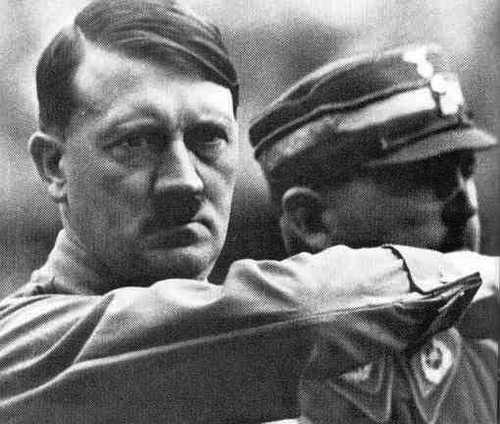
German Leadership
"Festliche Nurnburg" - Himmler and Rohm, 1933.
Leni Riefenstahl.
This image of Hitler and Ernst Rohm is a still from Leni Reifenstahl's first Nurenburg Rally movie - "Festlische Nurnburg", the official "documentary" of the first Nazi Party national rally following Hitler's accession to power, in 1933. Structurally, this movie is very similar to her masterpiece of the following year, "Triumph des Willen", the documentary of the 1934 Rally. In many other respects, the two are very different. "Festliche" is a mere 20 minutes long and, as the opening credits state, "All German newsreel companies contributed their film to the making of this film". In other words, Riefenstahl was significantly dependent on second-hand film derived from newsreel sources for this relatively modest and straightforward effort, and it shows. By contrast, "Triumph" is almost two hours long, and is the product of Riefenstahl's editing of some 60 hours of usable original footage filmed by Riefenstahl's own team. The agenda of the latter movie is also much more complex. One of the issues that Reifenstahl was clearly required to deal with in "Triumph" was the aftermath of the "Rohm Purge", which had taken place only a few months before the 1934 Rally. In "Festliche", the SA plays a huge part (not surprisingly), and Rohm himself features prominently, particularly in the second half of the movie. Rohm alone accompanies Hitler in the "tribute to the Fallen" scene, and stands with Hitler in his car, reviewing the grand parade with which the movie culminates. One of the objectives in producing "Triumph" was to displace the now-unusable "Festliche", confirming the airbrushing of Rohm out of Party history. However, the SA could still not be ignored; it plays a prominent part in the earlier part of the movie and in the climactic grand parade and, in an address to the SA specifically, Hitler (without mentioning Rohm) speaks of the "treason" of the "Night of the Long Knives" victims while reassuring them that this had nothing to do with the spirit and commitment of the SA as a whole. There are, however, balancing features. The National Socialist Labour Front - prominent in the earlier movie - is even more prominent in "Triumph", a prominence demanded, among other things, by the need of the Party to trumpet one of its earliest achievements, the rapid inception of the Autobahn-building programme. The change in status of the SS from SA satrapy to powerful, independent organisation of the Party is also reflected. In "Triumph's" tribute to the Fallen scene, Rohm's place is taken by his successor, Victor Lutze, along with Heinrich Himmler. Furthermore, the grand parade, while still featuring the SA, the Labour Front and the NSKK, also features a major march-past of General SS men. The final part of the parade consists of massed ranks of what was to become the SS-VT, the future Waffen-SS, consisting of LSSAH and Totenkopfverbande units, and the LSSAH marching band (almost every "military" SS man who could be spared from other duties must have been assembled to make up the numbers involved at this early date). While "Triumph" shows that SA power was still a reality, and a potential threat to the leadership in the latter part of 1934, it also shows the shift in power in the direction of Himmler and his "Asphalt Soldiers", a shift that would continue to the very end of the Reich. Best regards, JR.
4016 Views
11/5/2012
